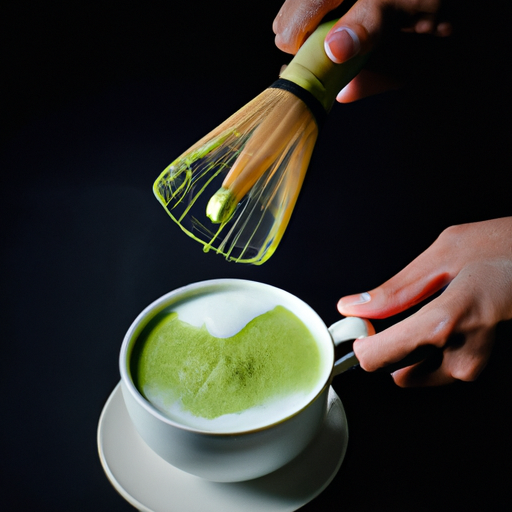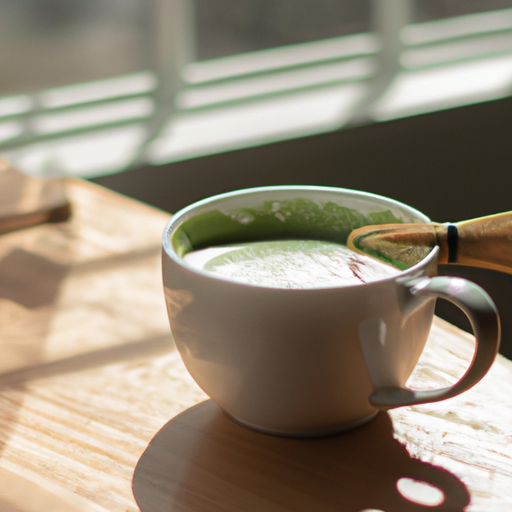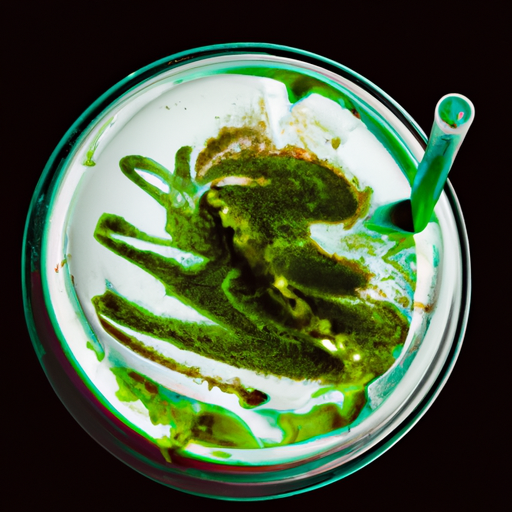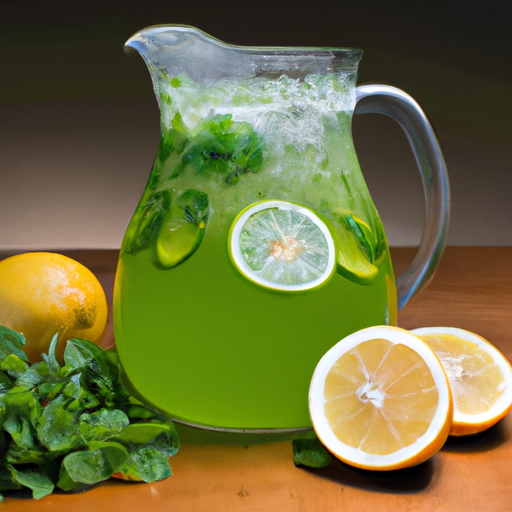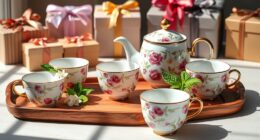I absolutely adore matcha lattes and have long been eager to master making them myself. Despite several initial mishaps, I ultimately unlocked the key to crafting the ideal matcha latte: employing a milk frother! The use of a milk frother simplifies the preparation immensely, while also producing a velvety, airy consistency that seems almost impossible to attain in its absence.
In this article, I’ll walk you through the steps of making a matcha latte with a milk frother. We’ll start by discussing what exactly matcha is and what ingredients you’ll need to gather. Then, I’ll guide you through the process of preparing the matcha powder and frothing the milk. We’ll also cover some tips for getting the perfect froth and troubleshooting common issues.
By the end of this article, you’ll be able to enjoy a delicious matcha latte in the comfort of your own home.
Key Takeaways
- Milk frother is an essential tool for making a perfect matcha latte.
- Different milk types, temperatures, and frothing techniques can affect foam consistency.
- Experiment with milk alternatives, sweeteners, and optional additions to find a preferred taste.
- Homemade matcha latte is a great way to incorporate antioxidants into your diet and enjoy a pick-me-up beverage.
What is Matcha?
So, you’re ready to make a matcha latte with your milk frother, but do you know what matcha actually is?
Matcha is a finely ground powder made from specially grown green tea leaves. Unlike traditional green tea, where the leaves are steeped and then discarded, matcha is whisked into water or milk and consumed in its entirety. This means that you get all of the benefits of green tea, including antioxidants and caffeine, in every sip.
Matcha is available in different grades, each with its own unique flavor, texture, and color. The highest grade, ceremonial matcha, is made from the youngest leaves and has a bright green color, smooth texture, and delicate flavor. This is the most expensive and is typically used for traditional tea ceremonies.
The next grade down, premium matcha, is slightly less expensive and has a slightly stronger flavor and darker color. The lowest grade, culinary matcha, is still high quality but is typically used in cooking and baking rather than drinking.
Now that you know what matcha is and the different grades available, it’s time to gather the necessary ingredients to make your matcha latte with a milk frother.
Gathering the Necessary Ingredients
First, you’ll want to grab all the goodies that’ll make your taste buds dance with joy. Gather up the creamy milk, the vibrant matcha powder, and any sweeteners you desire.
Choosing the right milk is essential to creating a perfect matcha latte. I recommend using whole milk or oat milk for a creamy, rich texture that complements the matcha flavor. Soy milk or almond milk can also be used, but they may alter the taste slightly. Experimenting with flavors is another fun way to spice up your latte. Vanilla extract or honey are great options that add a touch of sweetness without overpowering the matcha.
Next, measure out the matcha powder. You’ll need about 2 teaspoons for a single serving of matcha latte. Make sure to sift the matcha powder through a fine mesh sieve to prevent any clumps from forming. This will ensure a smooth and even consistency in your latte.
Now that you’ve gathered all the necessary ingredients and prepared the matcha powder, it’s time to move on to the next step: preparing the milk.
Preparing the Matcha Powder
First, I like to sift the matcha powder to remove any clumps and ensure a smooth texture. This is important because it helps to prevent any lumps or grains from forming in the final product.
Next, I add hot water to the matcha powder and whisk vigorously until it becomes frothy and well-mixed. This step is crucial because it helps to activate the flavor and aroma of the matcha powder, ensuring a rich and delicious taste.
Finally, I set the matcha powder aside to cool while I prepare the milk froth, before combining the two for the perfect matcha latte.
Sifting the Powder
Before you begin sifting the matcha powder, make sure your milk frother is ready for the next step.
Sifting the powder is essential because it breaks up any clumps and ensures a smooth and fine texture. Here are some sifting techniques to keep in mind:
- Use a fine mesh sifter or strainer to sift the matcha powder into a bowl.
- Gently tap the strainer to help the powder pass through.
- If there are any clumps left in the strainer, use a spoon or spatula to push them through.
- Repeat the sifting process until all the powder is fine and smooth.
Sifting the matcha powder is crucial because it improves the flavor and texture of your latte. Once you’ve sifted the matcha powder, it’s time to move on to the next step: adding hot water.
Adding Hot Water
Next up, it’s time to add some hot water to our sifted matcha powder! This step is crucial because it affects the taste and texture of the final product. The amount of water and its temperature can make or break your matcha latte. Therefore, it’s essential to pay attention to this step.
When adding hot water to the matcha powder, it’s best to use water that’s between 160°F to 180°F. Using boiling water can burn the matcha, resulting in a bitter taste. To make sure you get the right temperature, you can use a thermometer or let the water cool down for a few minutes after boiling. The amount of water you add depends on your preference. I usually add 2-3 ounces of water for a thick and creamy matcha latte. Once you’ve added the hot water, use a bamboo whisk or a frother to mix the matcha powder until it’s fully dissolved.
With the matcha powder dissolved, we are now ready to move on to the next step of frothing the milk.
Frothing the Milk
As the milk starts to swirl around in the frother, the anticipation for the creamy and velvety texture of the frothed milk builds within. The milk frother is an essential tool for making a perfect matcha latte, as it creates the perfect texture and consistency for the milk.
When it comes to choosing the milk for your latte, there are different options available, such as whole milk, almond milk, or oat milk. Each type of milk will have a different texture and taste when frothed, so it’s worth experimenting with different types to find your favorite.
To froth the milk, start by adding the milk to the frother and selecting the appropriate setting. Depending on the frother, there may be different settings available, such as cold or hot frothing, or different levels of frothiness. It’s important to follow the instructions for your specific frother to achieve the best results.
Once the frothing process is complete, the milk should be aerated and have a smooth, velvety texture.
Now that the milk is frothed, it’s time to combine it with the matcha. Gently pour the frothed milk into the cup with the matcha, using a spoon to hold back the foam. Then, use a whisk to mix the matcha and milk together until they’re fully combined.
The result should be a beautiful, creamy matcha latte with a frothy layer on top.
Combining the Matcha and Milk
Now that we have frothed the milk to perfection, it’s time to combine it with the matcha powder. This is where the magic happens and the matcha latte comes to life. As I mentioned earlier, using a milk frother is the best way to ensure that the milk and matcha powder are mixed together thoroughly, creating a smooth and creamy texture.
Before we start, let’s talk about milk alternatives. If you prefer a non-dairy option, almond, soy, or oat milk are all great choices. However, keep in mind that the type of milk you use affects the taste and texture of the latte. For instance, almond milk is naturally sweet, while soy milk has a nutty flavor that can overpower the matcha. Experiment with different milk alternatives to find the one that suits your taste buds the best.
To combine the matcha and milk, we will use a 3 column and 4 row table to guide us through the process. The table outlines the amount of matcha powder and milk needed for different serving sizes, making it easy to adjust the recipe to your liking. Simply pour the frothed milk into the matcha powder and whisk it until it’s well combined. The result should be a vibrant green color with a creamy consistency.
Now that we have combined the matcha and milk, it’s time to add a touch of sweetness to our latte. In the next section, we will explore different sweeteners that can be used, including honey, agave, and sugar. By adding a sweetener, we can balance out the bitter notes of the matcha and create a delicious and satisfying drink.
Adding Sweetener
Now that we’ve combined our matcha and milk, it’s time to add a touch of sweetness to our latte. There are various types of sweeteners you can use, such as sugar, honey, agave nectar, or stevia.
However, it’s important to note that each sweetener has a different taste and level of sweetness. So, it’s best to start with a small amount and gradually add more to taste. As a general rule, for a 12-ounce latte, one to two teaspoons of sweetener should suffice.
Types of Sweeteners
Get ready to add some sweetness to your matcha latte with your preferred type of sweetener! There are a variety of sweeteners to choose from, including natural and artificial options.
Natural sweeteners, such as honey, maple syrup, and agave nectar, are often preferred for their perceived health benefits and more complex flavor profiles. On the other hand, artificial sweeteners, such as Splenda and Equal, are often used for their low calorie count and lack of impact on blood sugar levels.
When selecting a sweetener for your matcha latte, consider the flavor and nutritional profile you desire. If you prefer a sweeter, more complex flavor, natural sweeteners may be the right choice for you. If you are looking for a low calorie option that won’t impact your blood sugar levels, artificial sweeteners may be a better option.
Regardless of which sweetener you choose, be sure to add it to your matcha latte in the recommended amount to achieve the desired flavor profile.
Recommended Amounts
Wondering how much sweetener to add to your matcha latte? Recommended amounts vary depending on the type of sweetener you choose.
For granulated sugar, usually a teaspoon or two is enough to sweeten a cup of matcha latte. However, for liquid sweeteners like honey or maple syrup, a little goes a long way, and just a small drizzle is all you need to add a touch of sweetness to your latte.
Measuring techniques are important when adding sweetener to your matcha latte. For accurate measurements, use measuring spoons or a kitchen scale to ensure that you add the right amount of sweetener.
Additionally, if you’re using milk alternatives, keep in mind that some of them are already sweetened. For example, vanilla-flavored almond milk can add sweetness to your matcha latte, so you may not need to add as much sweetener as you would with regular milk.
Now that you know how much sweetener to add to your matcha latte, let’s move on to some tips for getting the perfect froth.
Tips for Getting the Perfect Froth
To achieve the perfect froth for your matcha latte, you’ll want to make sure your milk is cold and your frother is fully charged. The foam consistency of your frothed milk is crucial to the overall taste and texture of your latte.
For best results, I recommend using whole milk, as it creates a thicker and creamier froth. Skim or low-fat milk can also be used, but the resulting foam will be thinner and less stable.
In addition to using the right type of milk, the temperature of your milk also plays a role in achieving the perfect froth. Cold milk straight from the fridge works best, as it creates a denser foam and allows for better control over the frothing process. Milk that is too warm or hot will result in a thinner and less stable foam.
I recommend using a thermometer to ensure that your milk is at the optimal temperature of around 40-50°C.
Once you have your cold milk at the right temperature, it’s time to froth it using your milk frother. Be sure to follow the instructions for your specific frother, as different models may require different techniques.
Generally, you’ll want to hold the frother just below the surface of the milk and turn it on, slowly moving it up and down to incorporate air into the milk. Keep frothing until you achieve the desired foam consistency, then pour it over your matcha tea.
With the perfect frothed milk, your matcha latte will be smooth, creamy, and delicious.
For optional additions, you can add a sweetener like honey or agave syrup, or experiment with different types of milk such as almond or oat milk. But before you do so, make sure you’ve mastered the art of frothing milk to perfection.
Optional Additions
You might be surprised to discover that there are many ways to enhance the flavor of your matcha latte with optional additions. Here are four flavor variations that you can add to your matcha latte to make it even more delicious:
- Add a few drops of vanilla extract to your matcha latte for a subtle, sweet flavor.
- For a natural sweetness, add a teaspoon of honey to your matcha latte. This also adds a slightly floral taste to your beverage.
- Sprinkle a pinch of cinnamon on top of your matcha latte for a warm, spicy flavor.
- Substitute regular milk with coconut milk to give your matcha latte a tropical twist.
Remember to experiment with different combinations of these flavor variations to find your perfect matcha latte. Incorporating optional additions can add a whole new dimension to your matcha latte experience.
Now that you know how to add additional flavors to your matcha latte, let’s move on to troubleshooting common issues that may arise when making matcha latte with a milk frother.
Troubleshooting Common Issues
If encountering problems while preparing a matcha latte with a milk frother, some common issues can be easily resolved with a few simple adjustments.
One common issue is lumpy matcha. If this happens, it could be the result of adding too much matcha powder or not whisking it enough before adding the milk. To fix this, try using less matcha powder or whisking it more vigorously before adding the milk to ensure it’s fully dissolved.
Another issue that may arise is the temperature of the milk. If the milk is too hot, it can scorch the matcha and result in a bitter taste. On the other hand, if the milk is too cold, it won’t froth properly. The ideal temperature for milk when making a matcha latte is between 140-160°F. To adjust the temperature, use a thermometer to check the milk temperature before adding it to the matcha.
By adjusting these simple factors, you can easily troubleshoot any issues and create a delicious matcha latte.
Now that you’ve perfected your matcha latte, it’s time to sit back and enjoy your homemade creation!
Enjoying Your Homemade Matcha Latte!
As I take a sip of my homemade matcha latte, the smooth and creamy texture combined with the earthy and slightly sweet taste of matcha fills my senses with pure delight.
Not only does this beverage satisfy my cravings for something sweet, but it also provides numerous health benefits. Matcha is known for its high concentration of antioxidants, which can help fight against free radicals and reduce the risk of chronic diseases.
If you’re not a fan of dairy or just want to mix things up, there are plenty of other milk alternatives you can use in your matcha latte. Almond milk, coconut milk, and oat milk are all great options that provide their own unique flavor and texture. Plus, they’re all vegan-friendly and lactose-free, making them a great option for those with dietary restrictions.
Overall, enjoying a homemade matcha latte is not only a delicious treat but also a great way to incorporate more antioxidants and other health benefits into your diet. So go ahead and get creative with your milk alternatives and enjoy this tasty and nutritious beverage whenever you’re in need of a pick-me-up.
Frequently Asked Questions
What is the difference between ceremonial grade and culinary grade matcha?
When it comes to selecting matcha, there are two main grades to consider: ceremonial and culinary.
Ceremonial grade matcha is considered the highest quality and is typically used in traditional Japanese tea ceremonies. It’s made from the youngest tea leaves, which are hand-picked and ground into a fine powder. The flavor is delicate and smooth, with a slightly sweet taste and a vibrant green color.
On the other hand, culinary grade matcha is more affordable and is often used in cooking and baking. It’s made from more mature leaves and has a slightly bitter taste, making it a good choice for blending with other ingredients.
When choosing between the two grades, it really depends on what you plan to use the matcha for. If you want to enjoy it as a pure tea, go for ceremonial grade. If you plan to use it in recipes or as a flavoring, culinary grade is a better choice. If you’re unsure, look for matcha that is bright green in color, smells fresh, and tastes smooth without any bitterness.
Can I use a handheld milk frother instead of a milk frothing machine?
Using a handheld milk frother instead of a milk frothing machine can produce similar results, but the frothing technique may differ slightly. The main advantage of a handheld frother is its portability and ease of use. Simply immerse the frother into the milk and turn it on to create a frothy texture.
However, a machine frother can produce a more consistent froth and can handle larger quantities of milk. When using a handheld frother, it’s important to use a tall and narrow container to prevent splashing and ensure even frothing.
Overall, both options can be effective for making a matcha latte, but it ultimately depends on personal preference and the tools available.
How much matcha powder should I use for one latte?
When it comes to making a matcha latte, one of the most important factors to consider is the quantity of matcha powder you use. Generally speaking, for a standard sized latte, you’ll want to use around 1-2 teaspoons of matcha powder.
Of course, the exact amount will depend on your personal preferences and the quality of your matcha powder. When adding the matcha powder to your milk, it’s important to use proper frothing techniques to ensure that the powder is fully incorporated and that the latte has a smooth, creamy texture.
Whether you’re using a handheld milk frother or a milk frothing machine, the key is to whisk the milk and matcha powder together until frothy and well combined. With a little practice, you’ll be able to create the perfect matcha latte every time!
What are some alternative sweeteners I can use besides honey or sugar?
When it comes to sweeteners for matcha lattes, there are plenty of alternatives to honey or sugar. Stevia is a popular choice for those who want a natural, zero-calorie option. It’s made from the stevia plant and can be found in liquid or powder form.
Another option is maple syrup, which adds a subtle sweetness and a hint of maple flavor. Just be sure to use the real stuff and not the artificially flavored syrups.
Other alternatives include agave nectar, coconut sugar, and monk fruit sweetener. When experimenting with sweeteners, it’s important to keep in mind the potency and sweetness level of each one, so you can adjust the amount accordingly.
How long does the froth typically last before it disappears?
When it comes to froth longevity, it really depends on the type of milk frother you’re using and how well you maintain it. Generally speaking, a good quality milk frother should be able to produce froth that lasts for at least a few minutes.
However, if you don’t clean your frother regularly or if you use it too frequently, the froth may not last as long. To ensure that your frother produces long-lasting froth, it’s important to clean it after each use and to follow the manufacturer’s instructions for maintenance.
This may include descaling the frother periodically, replacing worn out parts, and using the right type of milk for frothing. By taking good care of your milk frother, you can enjoy delicious frothy drinks for years to come.
Conclusion
In conclusion, making a matcha latte with a milk frother is a simple and rewarding process that can be easily mastered with practice. As a matcha lover, I’ve experimented with various ingredients and techniques to perfect my homemade matcha latte.
Through trial and error, I’ve discovered that the quality of matcha powder and the temperature of the milk are crucial factors that determine the taste and texture of the latte. Additionally, adjusting the frothing time and technique can also affect the final result.
Furthermore, while preparing a matcha latte may seem like a straightforward process, there are several theories and debates surrounding the best methods and ingredients. Some argue that using a bamboo whisk to prepare the matcha powder produces a smoother and more authentic flavor, while others swear by using a milk frother for a creamy and frothy latte.
Investigating these theories and experimenting with different techniques can add depth and complexity to the writing and enhance the overall experience of making a homemade matcha latte.

